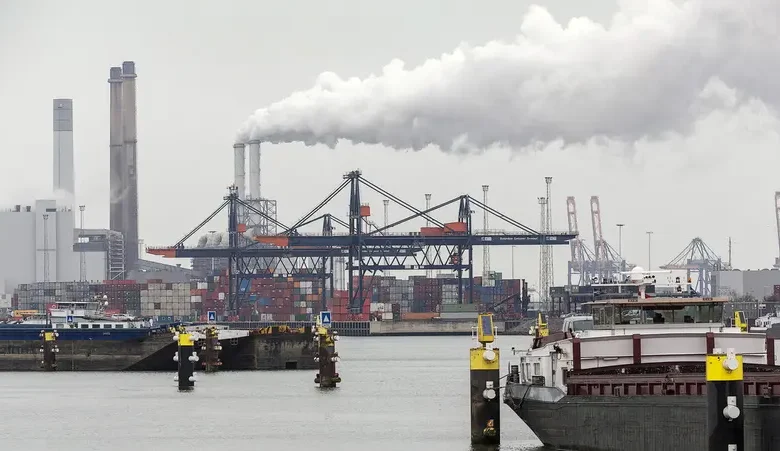Supply chain price pressures have healed yet their mark on inflation to endure

Supply chains across the world are healing up almost as fast as they broke down. That doesn’t mean the pressure they’re exerting on inflation will disappear as quickly.
Take the cost of shipping containers. Spot rates from Asia to the US West Coast increased more than 15-fold during the pandemic and have since returned to pre COVID-19 levels as trade between the world’s two largest economies cools from a frenzied pace.
But the relief is uneven. Short-term prices for containers from Europe to the US East Coast are still more than double what they were in late-2019, according to data from Freightos Ltd.
What’s more, an estimated 70 percentof goods transported in steel boxes on giant ships do so under long-term contracts — not the spot market — and those deals were renegotiated in 2021 and 2022 at much higher rates. Big retailers and manufacturers may not be seeing enough shipping-rate reductions yet to warrant slashing prices further.
“We need to be cautious about the drop in spot prices for containerized freight,” said Jason Miller, an associate professor of supply-chain management at Michigan State University. “Most freight moves under contract prices that are still well above pre COVID-19 levels.”
Such stickiness may help explain why inflation in some regions remains stubbornly high. US producer prices rebounded in January by more than expected, underscoring persistent inflationary pressures, and another closely watched gauge of consumer costs came in hotter than forecast on Friday. In the euro area, underly-ing inflation hit a record in January, revised data showed last week.
Another reason the cost of living is slow to fall: It’s easy to underestimate how long it can take for inflationary trends to work through supply chains. That’s partly because companies don’t like to change their pricing more than a couple of times a year, according to Chris Rogers, head of supply-chain research at S&P Global Market Intelligence.
“Whilst the underlying prices have been coming down, it could take quite a long time for that to feed in,” Rogers said. “We’re still seeing some of the inflationary hangover coming through to prod-uct pricing now and it could take much of the rest of the year for that to flow through to prices, whether it’s producer or consumer.”
“There are also some temporary factors at play now,” Rogers said.
In order to clear backlogs of inventory built up during the pandemic’s surge in consumer demand, many companies cut prices in the second half of last year.
Labor costs
But now many firms are facing enduring increases in one of their biggest costs: labor.
Worker shortages are hitting the supply-chain industries hard, said Nicholas Sly, vice president and economist at the Federal Reserve Bank of Kansas City.
“There are several parts of the logistics sector that are actually quite labor intensive,” Sly said. “Drivers make up a very notable part of this, but warehousing also requires a lot of workers,” he said.
It’s time consuming and costly to train new employees, and that drag on productivity only adds to costs. On top of higher paychecks, other basic costs of business have risen. Long-distance motor carrying is one sector that’s “not anywhere near pre-pandemic levels,” according to Michigan State’s Miller.
Higher costs for diesel, industrial equipment, and major capital expenses like new and used trucks still abound, he said. The cost to make truck trailers and chassis, for instance, remains elevated, according to data compiled by the St. Louis Fed. Driver wages have increased substantially, and so have maintenance charges on all modes of cargo transportation.
“Across the board, you have higher costs, so that’s going to have to translate to higher freight rates,” Miller said. “We may have seen ocean spot rates come back to their pre COVID-19 levels. We’re not seeing that in domestic truck transportation. We’re not seeing that in domestic rail-freight prices, either.”
Nor have storage costs seen any kind of sustained declines.
WarehouseQuote expects warehouse-storage pricing to continue growing this year, owing to industrial real estate rents and labor-cost increases, and as vacancy rates remain below historical av-erages.
Even so, the easing of some supply-chain strains means logistics issues are contributing far less to inflation than services, according to Flexport Inc.’s chief economist, Phil Levy.
In the US, consumer-inflation data earlier this month showed commodities, excluding food and energy, rose 1.4 percent from a year earlier — a rate that should give Federal Reserve officials some comfort that their policy tightening is having an effect, given they target annual inflation of 2 percent, albeit using a separate measure. But services inflation, minus energy services, is running at 7.2 percent.
“What we’ve had is something of a hand-off, where it went from really quick-spiking goods inflation to a big drop in the amount that’s coming from goods,” Levy said. “It’s not every single com-ponent of the supply chain has moved in lockstep, but things have let up quite a bit.”
In the latest wave of earnings reports, US retail chiefs highlighted improvements in logistics pressures, but the price pain isn’t necessarily over.
“While the supply-chain issues have largely abated, prices are still high and there is considerable pressure on the consumer,” Walmart Inc. Chief Financial Officer John David Rainey said on a conference call on Tuesday.
Gina Boswell, the CEO of Bath & Body Works Inc., said she sees economic headwinds from prices continuing for now, though that may change later in 2023.
“We expect that we will continue to see inflationary pressure on our input costs in the first quarter before beginning to see some relief as we move through the year,” she said on a conference call last week.










